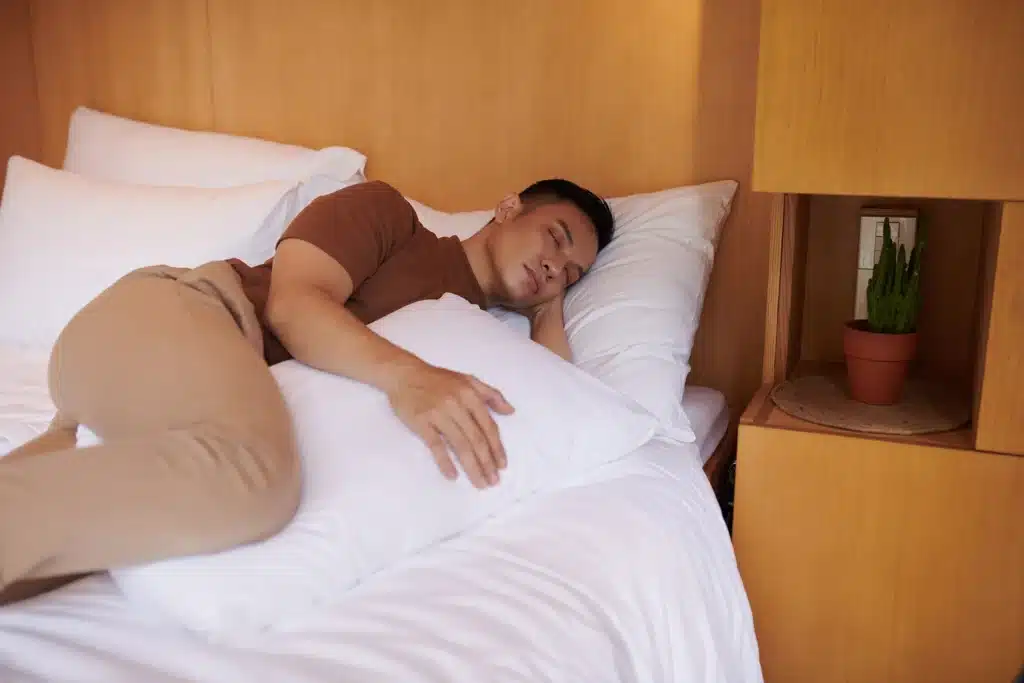
Table of Contents
ToggleFor those living on Long Island, a good night’s sleep might seem like a distant dream if you’re contending with persistent back pain.
At Long Island Neuroscience Specialists, we understand that agony, and we’re here to shed some light on the topic of back pain relief sleep. So, if you’re on the hunt for practical solutions for that irksome pain, keep reading!
The beauty of a peaceful night’s rest is something we often take for granted until we find ourselves tossing and turning due to a throbbing lower back.
While several factors can cause this annoyance, the position you sleep in can make a world of difference. For those who regularly yearn for back pain relief sleep, diving into the best sleeping positions might be your ticket to dreamland.
Every individual has a favorite sleep position, whether it’s sprawled out like a starfish or cuddled up like a cat. But if you’re looking for back pain relief sleep, the Fetal Position might be your best buddy.
The fetal position: a savior for many
This position helps to:
To get into this position:
Let’s get geeky for a moment. Our spine isn’t just a line of bones; it’s a complex structure. The way we lay our heads at night affects our entire body.
Proper alignment is like giving your body a comforting hug, reducing those pesky aches and helping with back pain relief sleep.
Imagine wearing shoes two sizes too small. Similarly, the wrong sleeping position can be a poor fit for your back. It’s all about spinal health and giving your back the love it needs to serve you right.
Spinal health it’s not just about bones; it’s about the muscles, nerves, and tissues intertwined there. A good sleeping position keeps everything in harmony, like an orchestra playing a perfect symphony.

Many individuals find themselves puzzled, waking up in the early hours with intensified lower back pain, especially when their day has been relatively uneventful.
So, why does this discomfort prefer to make its presence most known during the silent hours of the night? Let’s delve into this nocturnal mystery.
Often, we underestimate the wear and tear our bodies experience from mundane daily activities. It’s not always the weightlifting session at the gym or the heavy boxes we move that are the culprits.
Activities as simple as sitting at a desk for prolonged periods, bending to tie shoes, or even standing in one place for too long can accumulate strain on our lower backs.
Over the course of a day, these seemingly harmless tasks can subtly aggravate the back muscles and spinal discs, setting the stage for nighttime discomfort.
An undisturbed, restful sleep requires more than just a soft bed and a quiet room. The spine, in its wisdom, craves a specific alignment.
Even with the plushiest of mattresses, if our sleeping position throws the spine out of its desired alignment, it can result in muscle tension and pain.
Imagine your spine as a finely-tuned instrument; even a minor misalignment can throw the entire symphony off key.
Our bodies are a marvel of biological rhythms and hormonal balances. As day transitions to night, there’s a natural dip in the hormone cortisol, which plays a key role in managing inflammation.
With reduced cortisol levels at night, inflammation might increase in areas that need attention, like a vulnerable lower back. It’s almost as if our bodies, in their inherent wisdom, are signaling us with a flashlight, whispering, “This area needs care.”
In essence, the night’s silent hours can amplify what our bodies have subtly experienced all day.
Recognizing these factors can be the first step towards achieving that elusive back pain relief sleep.

Sleep should be a restorative process, a sanctuary where our bodies rejuvenate. However, for many individuals, the very act of sleeping can aggravate back pain. The key to unlocking back pain relief sleep is understanding spinal decompression.
Imagine gifting your spine a mini vacation every single night. Sounds dreamy, right? This is what spinal decompression feels like.
Our spines endure a lot during our waking hours—bending, lifting, twisting, and often staying static in poor positions. At night, it’s essential to alleviate this pressure, allowing the spine to relax and rejuvenate.
The term “neutral spine” might sound technical, but the concept is quite simple. Think of it as finding a balance, akin to striking the middle ground in a debate.
This doesn’t mean bending excessively or arching the back. Instead, it’s about achieving a relaxed, natural position where the spine isn’t under any undue stress. By maintaining a neutral spine, you encourage back pain relief sleep.
You wouldn’t sit on an uncomfortable couch, so why settle for a bed setup that doesn’t support your spine? Props, like well-placed pillows or specialized mattresses, can be game-changers. Picture them as luxurious loungers for your spine.
For instance, if you’re a side sleeper, a pillow between your knees can keep your spine aligned. On the other hand, back sleepers might benefit from a pillow beneath their knees to reduce lower back strain.
The ultimate goal isn’t just about sleeping without pain but achieving genuine back pain relief sleep where every night feels like a restorative retreat for your spine. With the right techniques and tools, this dream can become your nightly reality.

The age-old notion of seeking comfort in one’s bed when in pain seems universally accepted. After all, our beds are often equated with rest, relaxation, and recuperation.
However, when it comes to lower back pain and achieving back pain relief sleep, the relationship with our beds might be more complex than we initially thought.
Imagine a brief nap or a short lie-down after a tiring day. Sounds blissful, right? Indeed, a short period of rest can be rejuvenating, allowing muscles to relax and promoting healing.
But here’s the catch: While an occasional rest is beneficial, extended bed rest can start to resemble an unwelcome guest, lingering much longer than needed and bringing along a slew of problems.
Contrary to the impulse to lay motionless when in pain, gentle movements can be therapeutic. Think of them as a mini massage or a soft lullaby for your distressed back.
Simple stretches, or even merely altering your sleeping position periodically, can encourage blood flow, reduce muscle stiffness, and aid in back pain relief sleep.
There’s a darker side to spending too much time in bed, especially when dealing with back pain. Muscles, when not engaged in moderate activity, can begin to weaken.
This weakening can lead to reduced support for the spine, exacerbating pain in the long run. Moreover, extended bed rest can take a toll on one’s mental well-being, leading to feelings of isolation or even depression.
In essence, while our beds are a sanctuary for rest, it’s the balance between rest and activity that holds the key to genuine back pain relief sleep. Remember, like many things in life, moderation is vital!
When navigating the challenges of back pain, diversifying your relief strategies is essential. Relying solely on one method might not provide the comprehensive care your back needs.
By combining back pain relief sleep with other remedies, you can enhance your pain management journey, especially in the picturesque settings of Long Island.
Sleep isn’t the only time to attend to your back. The daylight hours offer a plethora of opportunities to strengthen and support your spine.
Consider a leisurely walk through one of Long Island’s lush parks. The natural surroundings not only provide a scenic backdrop but also promote holistic healing.
Walking can strengthen your core and back muscles while aligning your spine. Furthermore, infusing your daily routine with periodic stretches can keep your back agile, preventing stiffness and promoting mobility.
Beyond the basic activities, professional therapeutic approaches can significantly bolster your back pain relief sleep efforts. Physical therapy, for instance, provides targeted exercises and treatments designed for your specific back issues. It’s a structured approach that addresses both the symptoms and the root causes of your pain.
Massage therapy, on the other hand, focuses on relaxing those tense back muscles, improving circulation, and promoting overall relaxation – all crucial components for alleviating back discomfort.
Finally, considering a consultation with one of Long Island’s renowned neuroscience specialists can offer specialized insight. These experts can provide a deeper understanding of your back pain and recommend treatments tailored to your needs.
In the end, the journey to back pain relief sleep is multifaceted. By combining the restorative powers of sleep with daytime activities and professional therapies, you’re equipping yourself with a comprehensive toolkit to tackle back pain head-on.
When consistent efforts to achieve back pain relief sleep prove fruitless, spine surgery emerges as a potential solution worth considering. While it’s often seen as a last resort, for some, it’s the beacon of hope in a sea of sleepless nights marred by back pain.
Importantly, spine surgery isn’t a blanket solution. The world of spinal interventions is vast, comprising various surgical techniques tailored to address different issues. It’s essential to engage in a detailed conversation with a spine specialist. They can provide insights into the most appropriate surgical approach for your unique condition.
Of course, embarking on the surgical route means embracing the recovery process. It’s a commitment, a blend of patience and resilience. Yet, the prospect of waking up to mornings free from debilitating back pain can be a compelling motivator.
While surgery is not always the initial recommendation for back pain relief sleep, it stands as a transformative option for those whose lives are significantly hampered by persistent back issues. The promise of a pain-free future can make the surgical journey worthwhile.
Sleeping should be restful, not painful. By understanding our backs and taking steps towards optimal sleeping positions, the quest for back pain relief sleep becomes less of a dream and more of a reality.
If back pain is stealing your sleep, let’s chat. Long Island Neuroscience Specialists are here to guide you. We’re just a call away, ready to bring those restful nights back into your life.
GET IN TOUCH +
285 Sills Road
Building 5-6, Suite E
East Patchogue, NY 11772
(631) 475-5511
184 N. Belle Mead Road
East Setauket, NY 11733
(631) 675-6226
GET IN TOUCH +
285 Sills Road
Building 5-6, Suite E
East Patchogue, NY 11772
(631) 475-5511
184 N. Belle Mead Road
East Setauket, NY 11733
(631) 675-6226
SUBSCRIBE TO OUR NEWSLETTER +
Send us a Google review. Click this link and let us know how we did!
Review us on Yelp too.